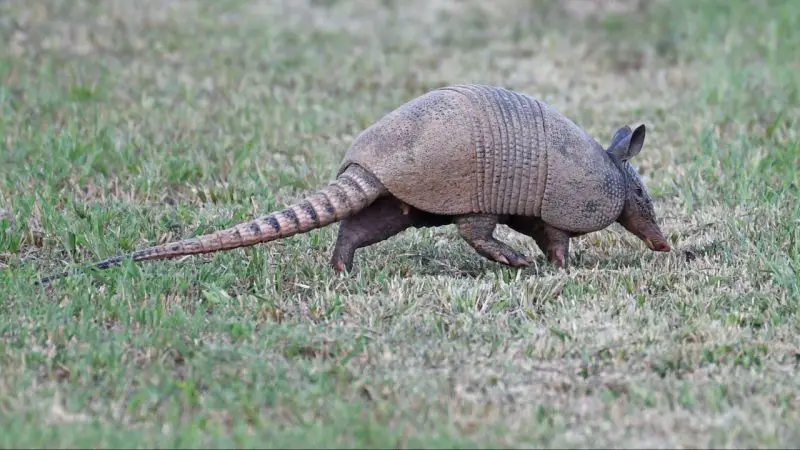Armadillos are not the first animals most people picture when thinking about Mississippi’s wildlife. The state is better known for its white-tailed deer, black bears, swamp rabbits, and flocks of wading birds along the Gulf Coast. Yet in the background—quietly, steadily, and with a peculiar method of movement—armadillos have carved out a surprising place in Mississippi’s ecological landscape.
They wander through pine forests, dig along the edges of farmland, nose through the undergrowth near bayous, and cross suburban lawns in the late evening hours. Many residents glimpse them only as quick silhouettes disappearing into brush or as faint rustles under shrubs at dusk. Others encounter them when inspecting their yards and discovering small, cone-shaped holes that appeared overnight. Few animals are as misunderstood yet as consistently present across the state’s habitats.
Mississippi’s warm climate, abundant food, and diverse soils create ideal conditions for the nine-banded armadillo—the only species found in the United States. Although they look unusual compared to other mammals in the South, armadillos exhibit remarkable survival traits, complex behaviors, and ecological influences that most people never notice.
This article explores ten fascinating facts about armadillos in Mississippi, revealing how these armored visitors shape the landscape in unexpected ways.
1. Armadillos in Mississippi are expanding northward faster than expected

The nine-banded armadillo was historically restricted to Central and South America. Only in the last century did it begin spreading through the southern United States. Mississippi quickly became a stronghold, providing rich soils, mild winters, and access to diverse prey.
Over the past several decades, the armadillo’s range has pushed steadily north. Warmer winters, reduced snow cover, and expanding forest–suburban edge habitats have all helped this expansion. Mississippi serves as both a permanent home and a launching point for further movement into Tennessee, Kentucky, and even parts of the Midwest.
Their northward progress surprises many wildlife researchers. Armadillos are sensitive to extreme cold, yet Mississippi’s climate acts as a buffer, allowing them to reproduce successfully and maintain year-round populations. Their continued spread reflects how adaptable these animals truly are.
2. Their shells are not hard armor plates but flexible bands of bone
The armadillo’s protective shell is its most iconic feature, but the texture and design are often misunderstood. Instead of a rigid suit of armor, the nine-banded armadillo’s shell is made of flexible bony plates covered by tough keratin.
These “bands” allow the armadillo to maneuver through dense brush, dig efficiently, and twist its body when reacting to predators. The flexibility gives them a survival advantage in Mississippi’s varied landscapes, from thick riverbank vegetation to the open understory of pine forests.
Although the shell provides protection, it is not impenetrable. Coyotes, dogs, and large birds of prey can occasionally breach it. Still, the unique combination of flexibility and rigidity makes this defense system one of the most unusual among North American mammals.
3. Armadillos have a powerful digging instinct shaped by Mississippi’s soils
Armadillos are natural excavators. Their strong claws, sturdy limbs, and low center of gravity allow them to dig quickly through a variety of soil types. Mississippi’s mix of loamy farmland, sandy coastal soils, and soft forest earth creates ideal conditions for armadillo activity.
They dig for three main reasons:
- Searching for food, primarily insects and larvae
- Creating burrows for daytime shelter and offspring
- Escaping predators rapidly by digging downward rather than running
A single armadillo may maintain several burrows within its territory. These burrows provide stable temperatures during summer heat and insulation during colder months. Mississippi homeowners often notice their presence when small entrances appear near foundations, shrubs, or woodpiles.
Despite the annoyance these holes cause, burrows play a role in aerating soil and creating microhabitats used by other wildlife, including frogs, small mammals, and certain reptile species.
4. Their diet consists almost entirely of insects, making them important pest controllers
Armadillos are opportunistic feeders, but insects form the bulk of their diet. Mississippi’s humid climate supports large populations of beetle larvae, ants, termites, grubs, and earthworms—perfect targets for armadillos.
Using a sensitive snout and strong forelimbs, they root through leaf litter and soil to find prey. They often detect insects through smell and vibrations, giving them an advantage when searching for hidden larvae beneath the surface.
Armadillos also occasionally eat berries, fungi, and carrion. However, their insect-heavy diet contributes significantly to controlling populations of common pests. Homeowners often experience fewer lawn grubs in areas where armadillos forage regularly, though the accompanying digging can be frustrating.
The ecological benefit is substantial: armadillos help regulate insect communities and reduce pest pressure on Mississippi’s gardens and agricultural zones.
5. Armadillos can jump straight into the air when startled
Although armadillos seem slow and clumsy at first glance, they possess a surprising defensive behavior. When startled, they often leap vertically into the air—sometimes over two feet high.
This reflex evolved in South American grasslands where armadillos needed to escape predators lurking in tall vegetation. In Mississippi, the behavior remains, though it can be counterproductive near roads. The sudden leap increases the chance of collision with vehicles, which is why armadillos often become roadkill despite their natural wariness.
The jump also helps them confuse predators. A coyote or bobcat expecting a ground-running escape may hesitate, giving the armadillo a brief chance to dig or flee.
6. The nine-banded armadillo almost always gives birth to four identical quadruplets
One of the most astounding biological traits of Mississippi’s armadillos is their reproductive pattern. Each mating season, the female nearly always gives birth to four genetically identical offspring. These quadruplets develop from a single fertilized egg that splits into four embryos.
This reproductive system is rare among mammals and contributes to rapid population growth when conditions are favorable. Mississippi’s long warm season and abundant food supply support high juvenile survival rates, helping armadillo numbers remain strong.
Their unusual reproductive strategy also provides opportunities for scientific study. Since the quadruplets are clones, researchers can examine genetic and environmental effects in ways that are difficult with other wild species.
7. Armadillos have surprisingly low body temperatures and poor insulation
Most mammals maintain high body temperatures, but armadillos operate differently. Their average body temperature is significantly lower than that of other medium-sized mammals. This trait makes them vulnerable to cold but well adapted to Mississippi’s warm climate.
Their shells offer little insulation, meaning they lose heat quickly when temperatures drop. As a result, armadillos are more active during warm nights and reduce movement during cold spells. In northern Mississippi, extended winter freezes can temporarily limit their activity.
Their metabolism is also slow, which influences how they forage and digest. They must consume large numbers of insects to maintain energy, and their low metabolic rate helps them conserve heat in cool conditions.
This unusual combination of traits explains why armadillos thrive best in Mississippi’s central and southern regions, where winter temperatures are mildest.
8. They are remarkably quiet animals with specialized smell-based foraging
Armadillos are not vocal animals. They rarely make sounds except for low grunts when foraging or subtle squeaks during interactions with young. Instead, they rely on body movement, smell, and ground vibrations to gather information.
Their sense of smell is highly developed. In Mississippi’s layered forest floors, they can detect insects several inches below the soil. Their long snout and sensitive nasal cavities help them pinpoint prey with surprising accuracy.
This reliance on smell allows them to navigate thick vegetation silently. Many residents only realize an armadillo is nearby when they hear the faint rustle of leaves as it digs or moves through undergrowth.
Their quiet nature makes them difficult to study in the wild, contributing to lingering misconceptions about how they behave and how widespread they truly are.
9. They play a complex role in Mississippi’s ecosystems—both beneficial and disruptive
Armadillos influence their environment in multiple ways. Some effects benefit the ecosystem, while others create conflict with human communities.
Positive ecological roles:
- Reduction of insect and pest populations
- Soil aeration through digging
- Creation of burrows used by other wildlife
- Seed dispersal through occasional fruit consumption
Negative impacts:
- Lawn and garden damage from extensive digging
- Undermining of small structures or erosion-prone soils
- Increased roadkill numbers along highways
- Competition with native small mammals for burrow space
Their influence is nuanced. While armadillos are not destructive on the scale of invasive species, their growing presence in Mississippi requires a careful balance between appreciation and management.
10. Armadillos can carry diseases, but the risks in Mississippi are often misunderstood
Armadillos are occasionally associated with disease transmission, particularly Hansen’s disease (leprosy). However, the actual risk is far lower than many assume.
Hansen’s disease is extremely difficult to contract. Transmission from armadillos requires prolonged, direct contact with bodily fluids—conditions unlikely to occur in casual outdoor encounters. Research indicates that only a small percentage of armadillos carry the bacterium, and infection in humans typically involves multiple factors.
More commonly, armadillos may harbor parasites or bacteria found in soil or on insects. These pose minimal risk unless someone handles the animals directly or consumes contaminated material.
In Mississippi, the best prevention is simply avoiding unnecessary contact with armadillos and observing them from a respectful distance. They are shy animals and rarely pose health risks to people.
FAQs About Armadillos in Mississippi
Are armadillos native to Mississippi?
No. They are native to Central and South America and expanded into Mississippi during the 20th century.
Why do armadillos dig in yards?
They search for insects and grubs. Lawns with high grub populations attract more digging.
Are armadillos dangerous?
They are shy and avoid humans. Direct handling is discouraged, but they are not aggressive.
Do armadillos carry leprosy?
A small percentage may carry the bacteria, but transmission to humans is rare and requires prolonged contact.
What do armadillos eat?
Mostly insects, grubs, larvae, ants, termites, and earthworms. They occasionally eat fruit and fungi.
When are armadillos most active?
Primarily at night. They forage from late evening until early morning, especially in warm weather.
How long do armadillos live in Mississippi?
Wild individuals typically live 7–10 years, depending on weather, predators, and road hazards.
Are armadillos harmful to the environment?
They can disturb lawns, but they also help control insects and create burrows used by other wildlife.
Why do armadillos get hit by cars so often?
Their habit of jumping straight up when startled increases the likelihood of vehicle collisions.
Can armadillos swim?
Yes. They can dog-paddle or walk underwater by holding their breath and letting their body weight sink.
Final Thoughts
Armadillos add an unexpected dimension to Mississippi’s wildlife. Their unusual armor, digging habits, dietary preferences, and surprising behavioral traits make them one of the most intriguing mammals in the state. While they are often overlooked or regarded as nuisances, they play a meaningful role in shaping soil structure, controlling insects, and expanding the diversity of Mississippi’s animal communities.
Watching an armadillo forage quietly along a forest edge or shuffle through leaf litter at dusk offers a reminder of how dynamic the state’s ecosystems truly are. Their growing presence reflects shifting climates, changing landscapes, and the resilience of wildlife capable of adapting to new environments.






